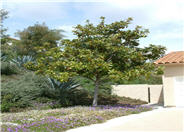
Common name:Carrotwood, Cupania
Botanical name:Cupaniopsis anacardioides
This evergreen tree will grow up to 40' high and has leathery, dark green leaves. When the trees approach maturity, yellow to orange fruit may be produced; it does well in wet soil.

Common name:Boston Ivy
Botanical name:Parthenocissus tricuspidata
This deciduous vine grows leaves that are usually lobed and divided into 3 leaflets. It clings tightly to any surface.

Common name:Southern Magnolia, Bull Bay
Botanical name:Magnolia grandiflora
Its large, simple, leathery appearance makes the pyramidal Magnolia grandiflora perfect for either a street or lawn tree. Its leaves are 4"-8" long, and its powerfully fragrant blooms are carried throughout the summer. Reddish brown cone shaped fruit appear in the fall. If these plants are grafted, they are more predictable (may take 15 years to bloom). Ungrafted trees will take only 2-3 years. Restricted root areas or heavy soils will slow the growth process.

Common name:Santa Barbara Daisy, Mexican Daisy
Botanical name:Erigeron karvinskianus
This low mounding perennial, with fine leaves and white to pinkish, daisy-like flowers, is an excellent asset to rock gardens.

Common name:Japanese Boxwood
Botanical name:Buxus microphylla japonica
Japanese Boxwood is often used as a hedge. It is compact, with small bright green leaves. It can reach 4'-6' tall and wide or be kept smaller through pruning. It can be sheared to shape. It does better in areas with milder winters.
| Designer: Julie Molinare | Patio Area |
Photographer: GardenSoft |
Soils and Compost:
Incorporate compost 6" into your soil to retain water, reduce compaction, feed earthworms, and provide valuable nutrients to your plants.
Water Saving Tip:
Check the soil's moisture level before watering.
You can reduce your water use 20-50% by regularly checking the soil before watering.
Integrated Pest Management:
Drip and other smart irrigation delivers water directly to roots, allowing no excess water for weeds.

